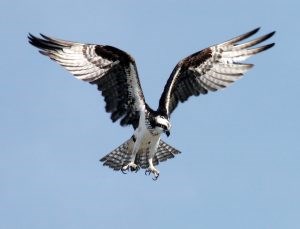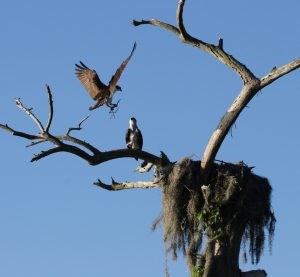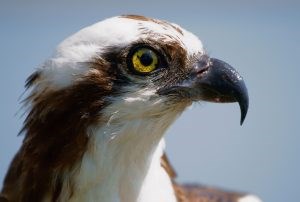This content was originally published by the Longmont Observer and is licensed under a Creative Commons license.
Spring is definitely here and the ospreys have returned to their nesting site at the Boulder County Fairgrounds. Once severely endangered due to the use of the pesticide DDT, the osprey has made an amazing comeback.
Some trace the name “osprey” back to the 1400s to the medieval phrase for “bird of prey,” avis prede. Others trace the name even farther back to the Latin word for “bone-breaker,” ossifragus. Comfortable around humans, ospreys may be one of the easier birds of prey to observe. Once classified with other hawks, the osprey is now in a separate family of its own.
Ospreys are large birds with a brown back and wings and white underparts. The head is white with a brown streak through the eye. Ospreys have a black beak that has a strong hook shape. In flight, you can see the white underparts with dark brown “wrists” on the wings and barred flight feathers. Females are about 15-20% larger than males, but the sexes are hard to distinguish from each other. Ospreys weigh 3-4.5 pounds and are 21-23 inches long. Their wingspan is 5-6 feet! For comparison, ospreys are about the size of a goose or larger.

Ospreys are typically found near water where there are large numbers of fish that congregate. Because of their diving habits, they prefer shallower water, but they may be found along fresh or salt water. Nesting sites are usually located within 12 miles of water and there must be elevated nesting sites available.
Ospreys feed almost exclusively on live fish and they can dive up to three feet below the water’s surface to catch fish. They are amazing anglers. Ospreys will hover when hunting and then dive feet first to catch a fish. Studies have shown that ospreys catch a fish on average one out of every four tries, but some ospreys can have up to a 70% success rate. They spend an average of 12 minutes hunting before they catch a fish.
The osprey’s feet are uniquely adapted to catching fish. Unique among hawks, they have a reversible outer toe so that they can grasp food with two toes in front and two toes behind. The soles of the feet have a barbed pad on them that helps them to hold onto slippery fish. Ospreys feed on fish that are usually 4-12 inches long. Although fish make up the majority of the diet, ospreys have been known to feed on small mammals, birds, or reptiles.

Ospreys have an acrobatic courtship display. The pair will circle high into the sky together. The male often flies high near the nest, often carrying a stick or a fish and then descending in a slow, undulating pattern over the nest. Ospreys are monogamous, but it is unknown how long pair bonds usually last. Occasionally, the male will mate with two females. In this case, the nests are close together so that the male can defend both sites. However, the second female gets fed less by the male and therefore may not have good nesting success. Ospreys generally breed from April to June.
Ospreys require elevated nest sites that are in open surroundings allowing for an easy approach. Nests are built in snags, treetops, the crotches of trees, or cliffs. Ospreys have also adapted readily to using manmade structures for nest sites. The male typically locates the nesting site prior to the female’s arrival. Once the female arrives at the nesting site, she is fed almost exclusively by the male. Males bring nesting material to the site and the female builds the nest.
The nest itself consists of sticks lined with smaller, softer material such as grass and algae. Ospreys reuse nests between years and so the nest can become quite large, even large enough for a human to sit in! Nests that have been continuously reused can range from 10-13 feet deep and 3-6 feet in diameter. Nests are bowl-shaped during incubation and become flattened out with a rim around the edge after the eggs hatch.

Females lay between one and four eggs with the average being three. Although both parents may incubate the eggs, the female does most of the incubating. Incubation lasts from 36-42 days. The young are hatched with down and open eyes. The first egg may hatch five days before the last egg. At first, the female broods the nestlings while the male brings food to the nest. In years where there is plenty of food, all the young will share the food. However, if food is scarce, the nestling that hatched first will outcompete the others for food and the younger nestlings may starve. After about 50 days, the young are capable of flight.
Ospreys have a loud musical chirping call. They will also give an alarm call near the nest. If you want to watch the ospreys in Longmont, you can go to the fairgrounds and watch them from the little lake there. Be sure to bring binoculars or a spotting scope for a good view. You can also watch them from the Boulder County Osprey Camera for a close up of the nest. Egg laying should be starting soon, so keep an eye on Longmont’s ospreys!


